Travel and Tourism Marketing Analysis
VerifiedAdded on 2020/06/06
|16
|4807
|62
AI Summary
The assignment delves into the world of travel and tourism marketing, examining key concepts like market segmentation, research methodologies (including PESTLE analysis), and the application of the marketing mix (7 Ps) in this specific industry. It also highlights the influence of online platforms and technology on contemporary marketing strategies within travel and tourism.
Contribute Materials
Your contribution can guide someone’s learning journey. Share your
documents today.
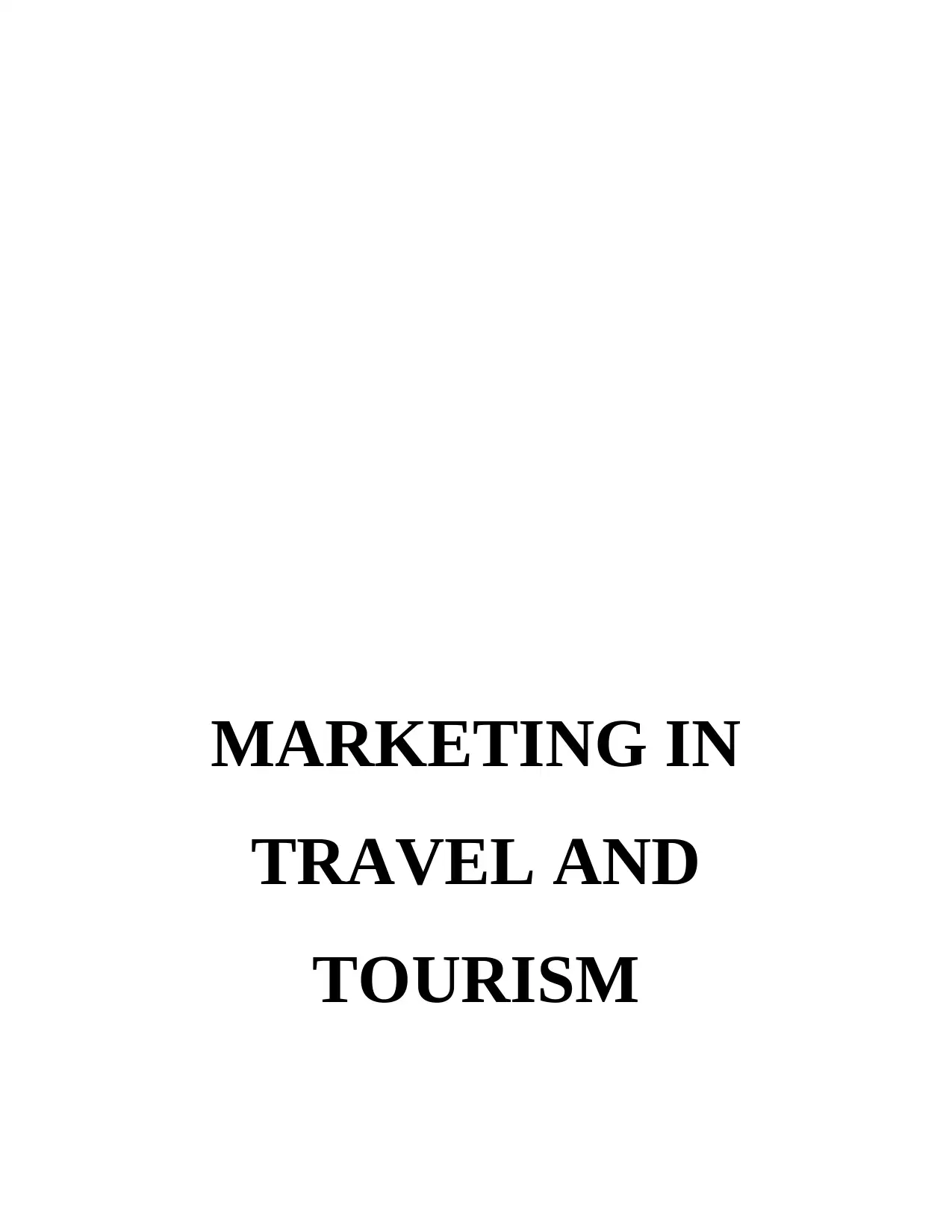
MARKETING IN
TRAVEL AND
TOURISM
TRAVEL AND
TOURISM
Secure Best Marks with AI Grader
Need help grading? Try our AI Grader for instant feedback on your assignments.
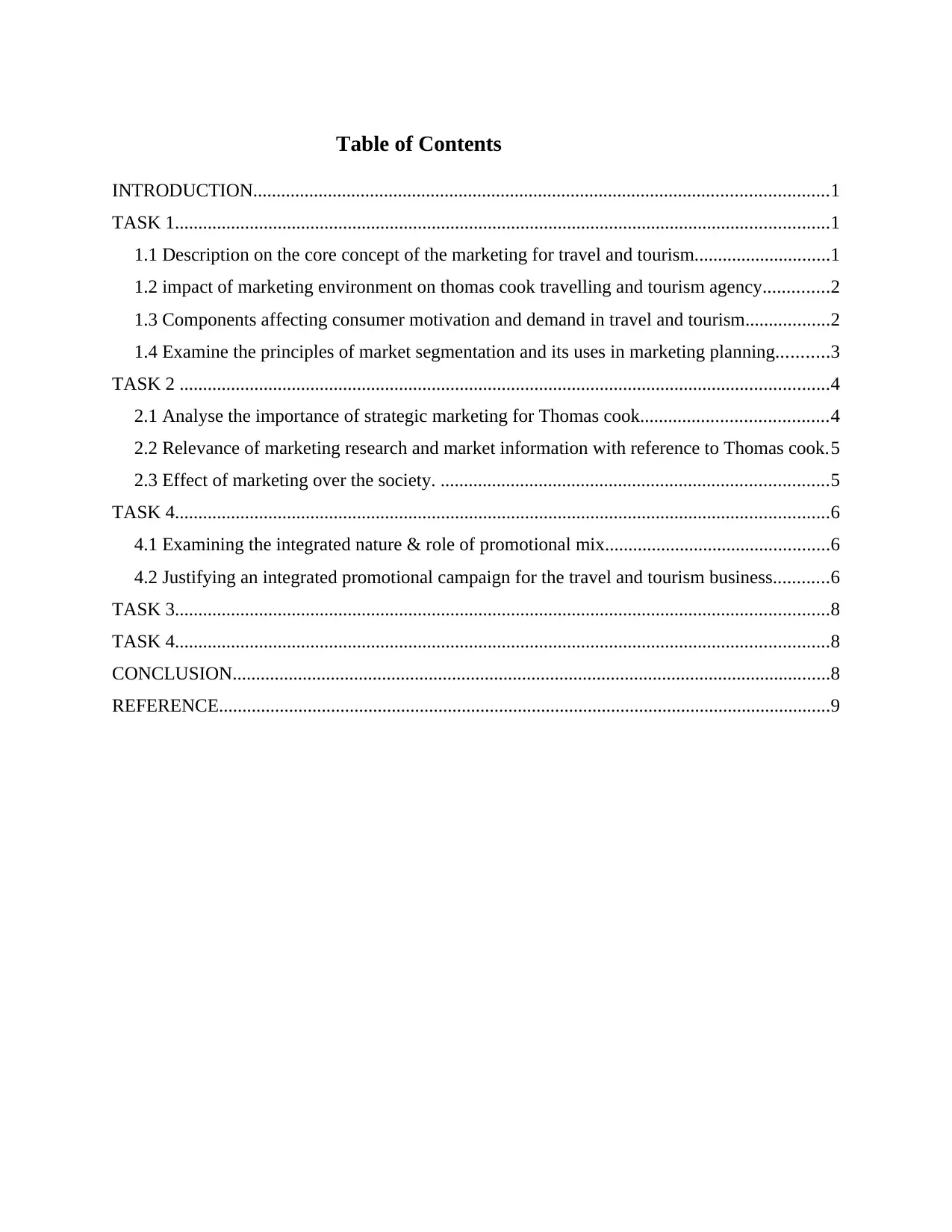
Table of Contents
INTRODUCTION...........................................................................................................................1
TASK 1............................................................................................................................................1
1.1 Description on the core concept of the marketing for travel and tourism.............................1
1.2 impact of marketing environment on thomas cook travelling and tourism agency..............2
1.3 Components affecting consumer motivation and demand in travel and tourism..................2
1.4 Examine the principles of market segmentation and its uses in marketing planning...........3
TASK 2 ...........................................................................................................................................4
2.1 Analyse the importance of strategic marketing for Thomas cook........................................4
2.2 Relevance of marketing research and market information with reference to Thomas cook.5
2.3 Effect of marketing over the society. ...................................................................................5
TASK 4............................................................................................................................................6
4.1 Examining the integrated nature & role of promotional mix................................................6
4.2 Justifying an integrated promotional campaign for the travel and tourism business............6
TASK 3............................................................................................................................................8
TASK 4............................................................................................................................................8
CONCLUSION................................................................................................................................8
REFERENCE...................................................................................................................................9
INTRODUCTION...........................................................................................................................1
TASK 1............................................................................................................................................1
1.1 Description on the core concept of the marketing for travel and tourism.............................1
1.2 impact of marketing environment on thomas cook travelling and tourism agency..............2
1.3 Components affecting consumer motivation and demand in travel and tourism..................2
1.4 Examine the principles of market segmentation and its uses in marketing planning...........3
TASK 2 ...........................................................................................................................................4
2.1 Analyse the importance of strategic marketing for Thomas cook........................................4
2.2 Relevance of marketing research and market information with reference to Thomas cook.5
2.3 Effect of marketing over the society. ...................................................................................5
TASK 4............................................................................................................................................6
4.1 Examining the integrated nature & role of promotional mix................................................6
4.2 Justifying an integrated promotional campaign for the travel and tourism business............6
TASK 3............................................................................................................................................8
TASK 4............................................................................................................................................8
CONCLUSION................................................................................................................................8
REFERENCE...................................................................................................................................9
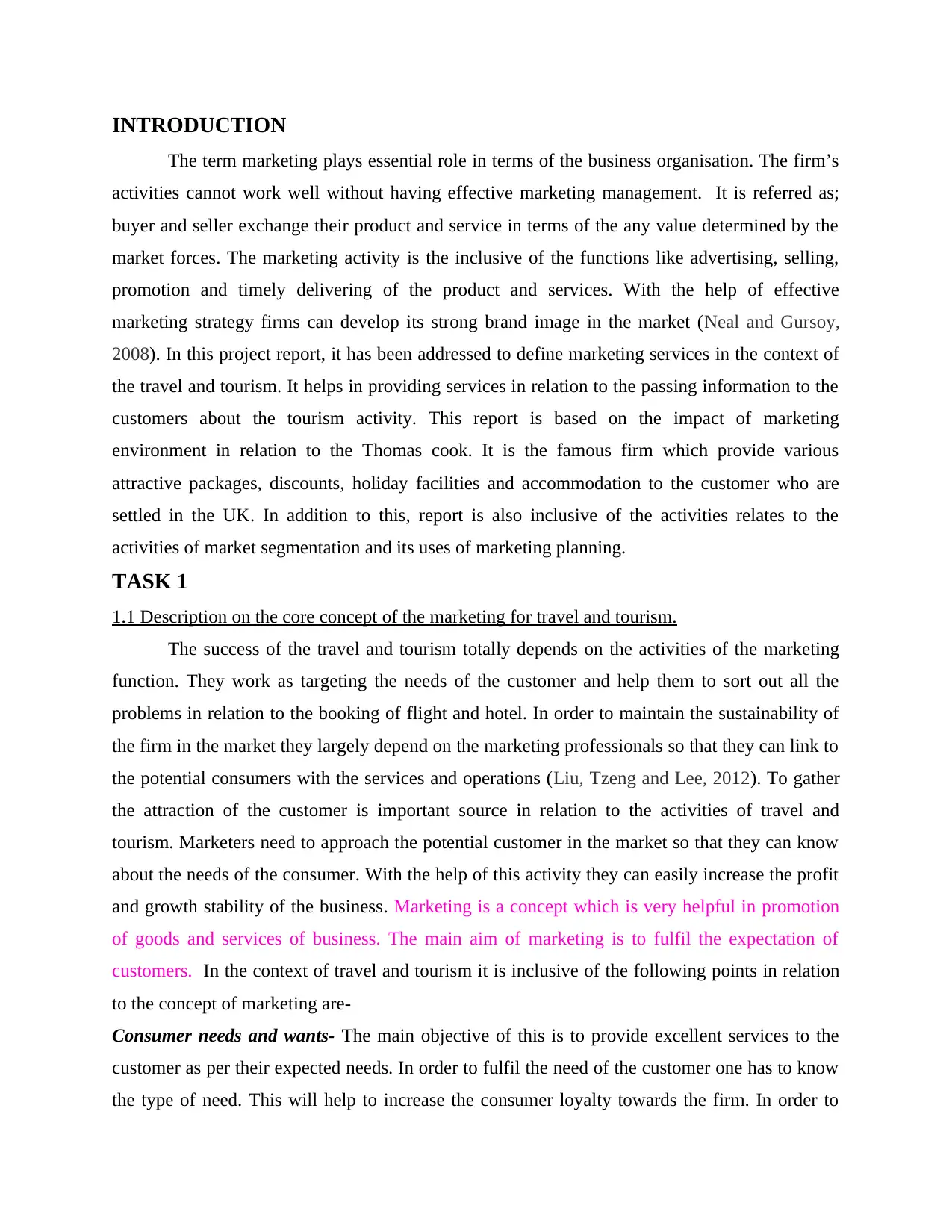
INTRODUCTION
The term marketing plays essential role in terms of the business organisation. The firm’s
activities cannot work well without having effective marketing management. It is referred as;
buyer and seller exchange their product and service in terms of the any value determined by the
market forces. The marketing activity is the inclusive of the functions like advertising, selling,
promotion and timely delivering of the product and services. With the help of effective
marketing strategy firms can develop its strong brand image in the market (Neal and Gursoy,
2008). In this project report, it has been addressed to define marketing services in the context of
the travel and tourism. It helps in providing services in relation to the passing information to the
customers about the tourism activity. This report is based on the impact of marketing
environment in relation to the Thomas cook. It is the famous firm which provide various
attractive packages, discounts, holiday facilities and accommodation to the customer who are
settled in the UK. In addition to this, report is also inclusive of the activities relates to the
activities of market segmentation and its uses of marketing planning.
TASK 1
1.1 Description on the core concept of the marketing for travel and tourism.
The success of the travel and tourism totally depends on the activities of the marketing
function. They work as targeting the needs of the customer and help them to sort out all the
problems in relation to the booking of flight and hotel. In order to maintain the sustainability of
the firm in the market they largely depend on the marketing professionals so that they can link to
the potential consumers with the services and operations (Liu, Tzeng and Lee, 2012). To gather
the attraction of the customer is important source in relation to the activities of travel and
tourism. Marketers need to approach the potential customer in the market so that they can know
about the needs of the consumer. With the help of this activity they can easily increase the profit
and growth stability of the business. Marketing is a concept which is very helpful in promotion
of goods and services of business. The main aim of marketing is to fulfil the expectation of
customers. In the context of travel and tourism it is inclusive of the following points in relation
to the concept of marketing are-
Consumer needs and wants- The main objective of this is to provide excellent services to the
customer as per their expected needs. In order to fulfil the need of the customer one has to know
the type of need. This will help to increase the consumer loyalty towards the firm. In order to
The term marketing plays essential role in terms of the business organisation. The firm’s
activities cannot work well without having effective marketing management. It is referred as;
buyer and seller exchange their product and service in terms of the any value determined by the
market forces. The marketing activity is the inclusive of the functions like advertising, selling,
promotion and timely delivering of the product and services. With the help of effective
marketing strategy firms can develop its strong brand image in the market (Neal and Gursoy,
2008). In this project report, it has been addressed to define marketing services in the context of
the travel and tourism. It helps in providing services in relation to the passing information to the
customers about the tourism activity. This report is based on the impact of marketing
environment in relation to the Thomas cook. It is the famous firm which provide various
attractive packages, discounts, holiday facilities and accommodation to the customer who are
settled in the UK. In addition to this, report is also inclusive of the activities relates to the
activities of market segmentation and its uses of marketing planning.
TASK 1
1.1 Description on the core concept of the marketing for travel and tourism.
The success of the travel and tourism totally depends on the activities of the marketing
function. They work as targeting the needs of the customer and help them to sort out all the
problems in relation to the booking of flight and hotel. In order to maintain the sustainability of
the firm in the market they largely depend on the marketing professionals so that they can link to
the potential consumers with the services and operations (Liu, Tzeng and Lee, 2012). To gather
the attraction of the customer is important source in relation to the activities of travel and
tourism. Marketers need to approach the potential customer in the market so that they can know
about the needs of the consumer. With the help of this activity they can easily increase the profit
and growth stability of the business. Marketing is a concept which is very helpful in promotion
of goods and services of business. The main aim of marketing is to fulfil the expectation of
customers. In the context of travel and tourism it is inclusive of the following points in relation
to the concept of marketing are-
Consumer needs and wants- The main objective of this is to provide excellent services to the
customer as per their expected needs. In order to fulfil the need of the customer one has to know
the type of need. This will help to increase the consumer loyalty towards the firm. In order to
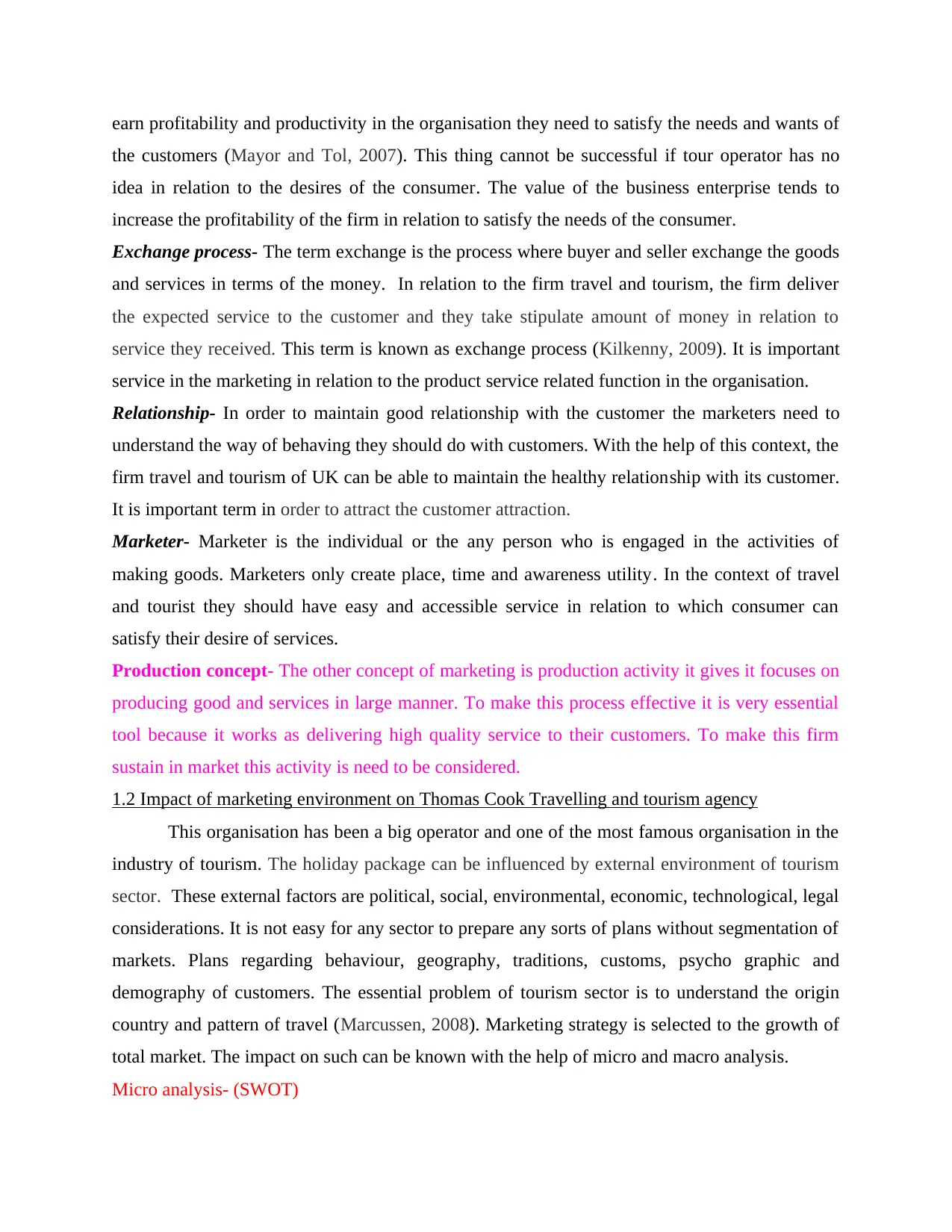
earn profitability and productivity in the organisation they need to satisfy the needs and wants of
the customers (Mayor and Tol, 2007). This thing cannot be successful if tour operator has no
idea in relation to the desires of the consumer. The value of the business enterprise tends to
increase the profitability of the firm in relation to satisfy the needs of the consumer.
Exchange process- The term exchange is the process where buyer and seller exchange the goods
and services in terms of the money. In relation to the firm travel and tourism, the firm deliver
the expected service to the customer and they take stipulate amount of money in relation to
service they received. This term is known as exchange process (Kilkenny, 2009). It is important
service in the marketing in relation to the product service related function in the organisation.
Relationship- In order to maintain good relationship with the customer the marketers need to
understand the way of behaving they should do with customers. With the help of this context, the
firm travel and tourism of UK can be able to maintain the healthy relationship with its customer.
It is important term in order to attract the customer attraction.
Marketer- Marketer is the individual or the any person who is engaged in the activities of
making goods. Marketers only create place, time and awareness utility. In the context of travel
and tourist they should have easy and accessible service in relation to which consumer can
satisfy their desire of services.
Production concept- The other concept of marketing is production activity it gives it focuses on
producing good and services in large manner. To make this process effective it is very essential
tool because it works as delivering high quality service to their customers. To make this firm
sustain in market this activity is need to be considered.
1.2 Impact of marketing environment on Thomas Cook Travelling and tourism agency
This organisation has been a big operator and one of the most famous organisation in the
industry of tourism. The holiday package can be influenced by external environment of tourism
sector. These external factors are political, social, environmental, economic, technological, legal
considerations. It is not easy for any sector to prepare any sorts of plans without segmentation of
markets. Plans regarding behaviour, geography, traditions, customs, psycho graphic and
demography of customers. The essential problem of tourism sector is to understand the origin
country and pattern of travel (Marcussen, 2008). Marketing strategy is selected to the growth of
total market. The impact on such can be known with the help of micro and macro analysis.
Micro analysis- (SWOT)
the customers (Mayor and Tol, 2007). This thing cannot be successful if tour operator has no
idea in relation to the desires of the consumer. The value of the business enterprise tends to
increase the profitability of the firm in relation to satisfy the needs of the consumer.
Exchange process- The term exchange is the process where buyer and seller exchange the goods
and services in terms of the money. In relation to the firm travel and tourism, the firm deliver
the expected service to the customer and they take stipulate amount of money in relation to
service they received. This term is known as exchange process (Kilkenny, 2009). It is important
service in the marketing in relation to the product service related function in the organisation.
Relationship- In order to maintain good relationship with the customer the marketers need to
understand the way of behaving they should do with customers. With the help of this context, the
firm travel and tourism of UK can be able to maintain the healthy relationship with its customer.
It is important term in order to attract the customer attraction.
Marketer- Marketer is the individual or the any person who is engaged in the activities of
making goods. Marketers only create place, time and awareness utility. In the context of travel
and tourist they should have easy and accessible service in relation to which consumer can
satisfy their desire of services.
Production concept- The other concept of marketing is production activity it gives it focuses on
producing good and services in large manner. To make this process effective it is very essential
tool because it works as delivering high quality service to their customers. To make this firm
sustain in market this activity is need to be considered.
1.2 Impact of marketing environment on Thomas Cook Travelling and tourism agency
This organisation has been a big operator and one of the most famous organisation in the
industry of tourism. The holiday package can be influenced by external environment of tourism
sector. These external factors are political, social, environmental, economic, technological, legal
considerations. It is not easy for any sector to prepare any sorts of plans without segmentation of
markets. Plans regarding behaviour, geography, traditions, customs, psycho graphic and
demography of customers. The essential problem of tourism sector is to understand the origin
country and pattern of travel (Marcussen, 2008). Marketing strategy is selected to the growth of
total market. The impact on such can be known with the help of micro and macro analysis.
Micro analysis- (SWOT)
Secure Best Marks with AI Grader
Need help grading? Try our AI Grader for instant feedback on your assignments.
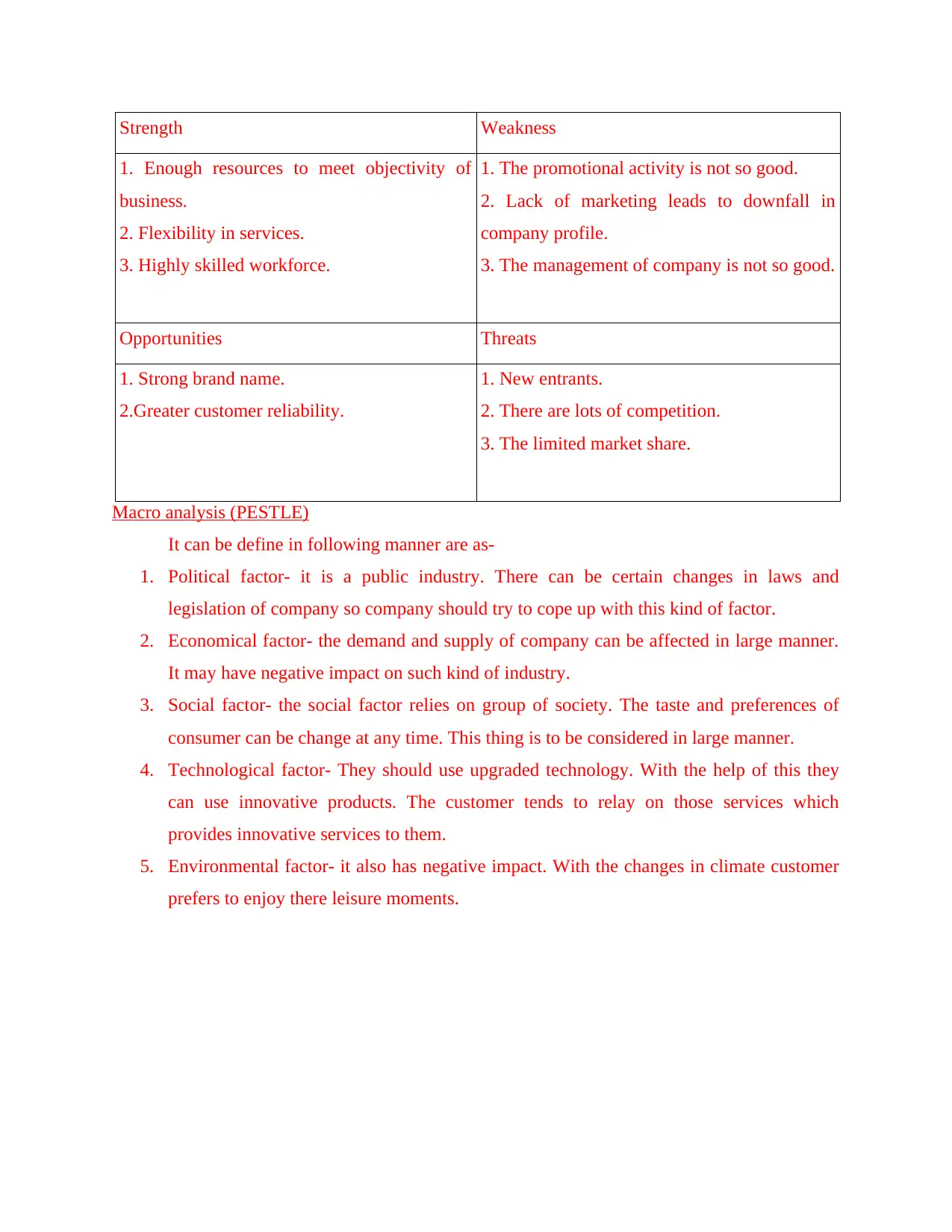
Strength Weakness
1. Enough resources to meet objectivity of
business.
2. Flexibility in services.
3. Highly skilled workforce.
1. The promotional activity is not so good.
2. Lack of marketing leads to downfall in
company profile.
3. The management of company is not so good.
Opportunities Threats
1. Strong brand name.
2.Greater customer reliability.
1. New entrants.
2. There are lots of competition.
3. The limited market share.
Macro analysis (PESTLE)
It can be define in following manner are as-
1. Political factor- it is a public industry. There can be certain changes in laws and
legislation of company so company should try to cope up with this kind of factor.
2. Economical factor- the demand and supply of company can be affected in large manner.
It may have negative impact on such kind of industry.
3. Social factor- the social factor relies on group of society. The taste and preferences of
consumer can be change at any time. This thing is to be considered in large manner.
4. Technological factor- They should use upgraded technology. With the help of this they
can use innovative products. The customer tends to relay on those services which
provides innovative services to them.
5. Environmental factor- it also has negative impact. With the changes in climate customer
prefers to enjoy there leisure moments.
1. Enough resources to meet objectivity of
business.
2. Flexibility in services.
3. Highly skilled workforce.
1. The promotional activity is not so good.
2. Lack of marketing leads to downfall in
company profile.
3. The management of company is not so good.
Opportunities Threats
1. Strong brand name.
2.Greater customer reliability.
1. New entrants.
2. There are lots of competition.
3. The limited market share.
Macro analysis (PESTLE)
It can be define in following manner are as-
1. Political factor- it is a public industry. There can be certain changes in laws and
legislation of company so company should try to cope up with this kind of factor.
2. Economical factor- the demand and supply of company can be affected in large manner.
It may have negative impact on such kind of industry.
3. Social factor- the social factor relies on group of society. The taste and preferences of
consumer can be change at any time. This thing is to be considered in large manner.
4. Technological factor- They should use upgraded technology. With the help of this they
can use innovative products. The customer tends to relay on those services which
provides innovative services to them.
5. Environmental factor- it also has negative impact. With the changes in climate customer
prefers to enjoy there leisure moments.
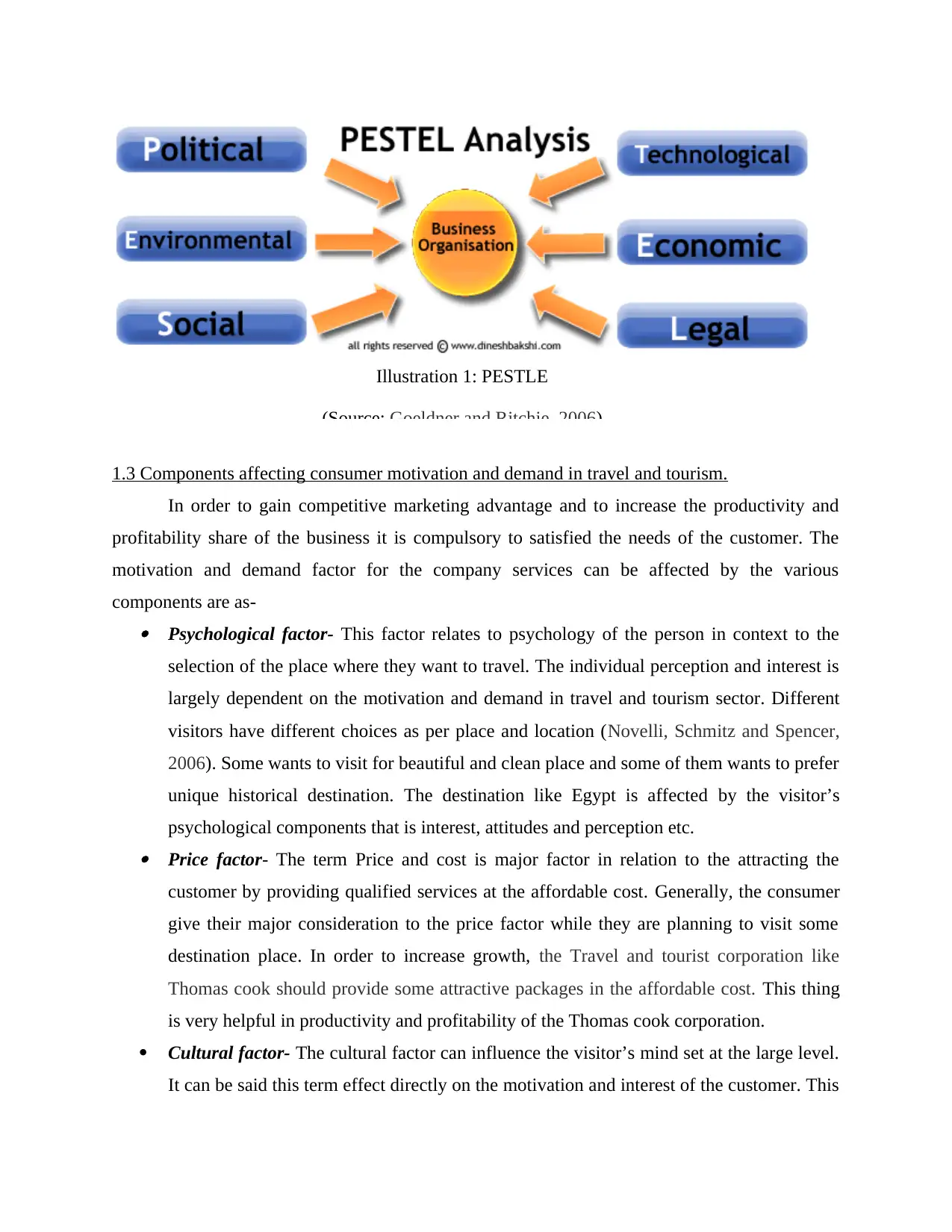
Illustration 1: PESTLE
(Source: Goeldner and Ritchie, 2006)
1.3 Components affecting consumer motivation and demand in travel and tourism.
In order to gain competitive marketing advantage and to increase the productivity and
profitability share of the business it is compulsory to satisfied the needs of the customer. The
motivation and demand factor for the company services can be affected by the various
components are as- Psychological factor- This factor relates to psychology of the person in context to the
selection of the place where they want to travel. The individual perception and interest is
largely dependent on the motivation and demand in travel and tourism sector. Different
visitors have different choices as per place and location (Novelli, Schmitz and Spencer,
2006). Some wants to visit for beautiful and clean place and some of them wants to prefer
unique historical destination. The destination like Egypt is affected by the visitor’s
psychological components that is interest, attitudes and perception etc. Price factor- The term Price and cost is major factor in relation to the attracting the
customer by providing qualified services at the affordable cost. Generally, the consumer
give their major consideration to the price factor while they are planning to visit some
destination place. In order to increase growth, the Travel and tourist corporation like
Thomas cook should provide some attractive packages in the affordable cost. This thing
is very helpful in productivity and profitability of the Thomas cook corporation.
Cultural factor- The cultural factor can influence the visitor’s mind set at the large level.
It can be said this term effect directly on the motivation and interest of the customer. This
(Source: Goeldner and Ritchie, 2006)
1.3 Components affecting consumer motivation and demand in travel and tourism.
In order to gain competitive marketing advantage and to increase the productivity and
profitability share of the business it is compulsory to satisfied the needs of the customer. The
motivation and demand factor for the company services can be affected by the various
components are as- Psychological factor- This factor relates to psychology of the person in context to the
selection of the place where they want to travel. The individual perception and interest is
largely dependent on the motivation and demand in travel and tourism sector. Different
visitors have different choices as per place and location (Novelli, Schmitz and Spencer,
2006). Some wants to visit for beautiful and clean place and some of them wants to prefer
unique historical destination. The destination like Egypt is affected by the visitor’s
psychological components that is interest, attitudes and perception etc. Price factor- The term Price and cost is major factor in relation to the attracting the
customer by providing qualified services at the affordable cost. Generally, the consumer
give their major consideration to the price factor while they are planning to visit some
destination place. In order to increase growth, the Travel and tourist corporation like
Thomas cook should provide some attractive packages in the affordable cost. This thing
is very helpful in productivity and profitability of the Thomas cook corporation.
Cultural factor- The cultural factor can influence the visitor’s mind set at the large level.
It can be said this term effect directly on the motivation and interest of the customer. This
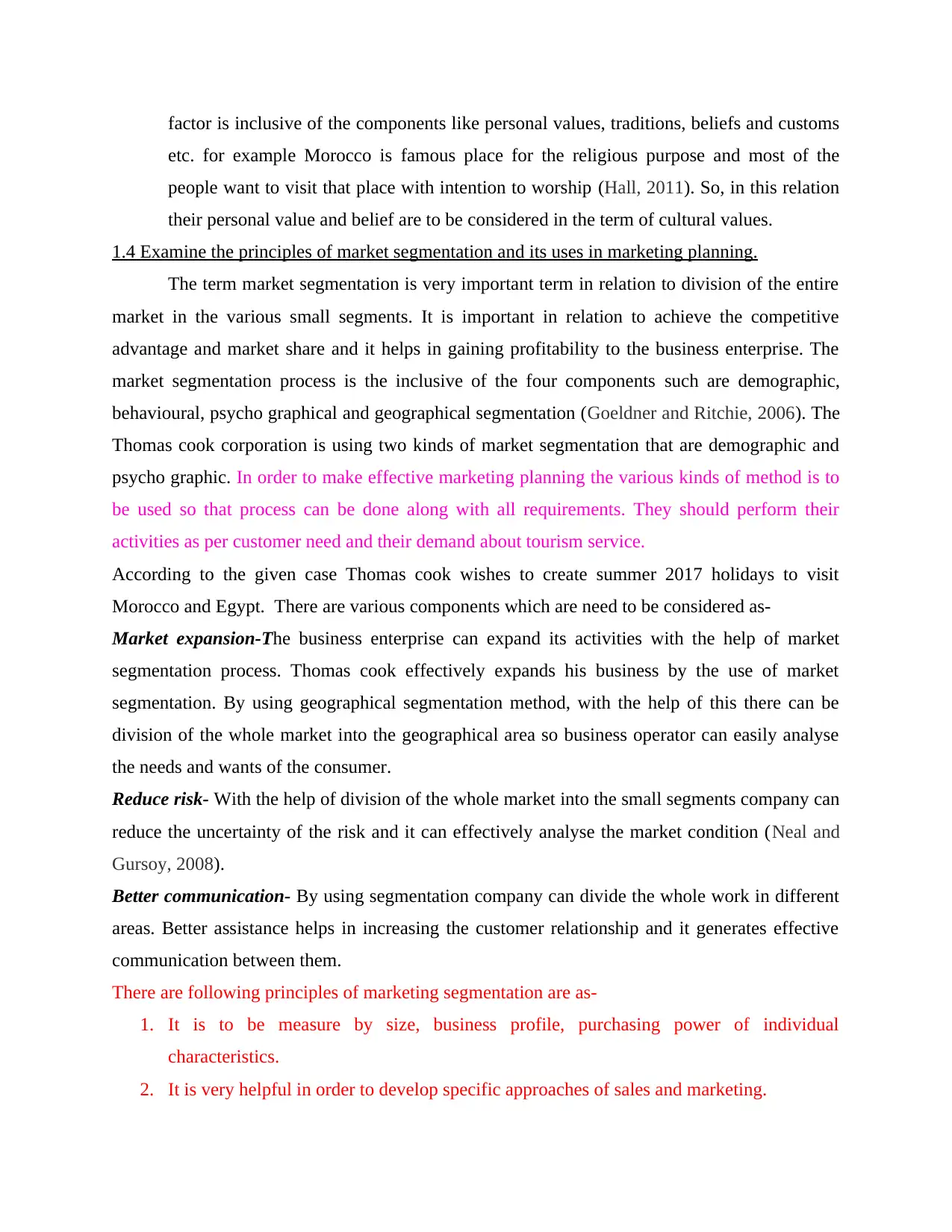
factor is inclusive of the components like personal values, traditions, beliefs and customs
etc. for example Morocco is famous place for the religious purpose and most of the
people want to visit that place with intention to worship (Hall, 2011). So, in this relation
their personal value and belief are to be considered in the term of cultural values.
1.4 Examine the principles of market segmentation and its uses in marketing planning.
The term market segmentation is very important term in relation to division of the entire
market in the various small segments. It is important in relation to achieve the competitive
advantage and market share and it helps in gaining profitability to the business enterprise. The
market segmentation process is the inclusive of the four components such are demographic,
behavioural, psycho graphical and geographical segmentation (Goeldner and Ritchie, 2006). The
Thomas cook corporation is using two kinds of market segmentation that are demographic and
psycho graphic. In order to make effective marketing planning the various kinds of method is to
be used so that process can be done along with all requirements. They should perform their
activities as per customer need and their demand about tourism service.
According to the given case Thomas cook wishes to create summer 2017 holidays to visit
Morocco and Egypt. There are various components which are need to be considered as-
Market expansion-The business enterprise can expand its activities with the help of market
segmentation process. Thomas cook effectively expands his business by the use of market
segmentation. By using geographical segmentation method, with the help of this there can be
division of the whole market into the geographical area so business operator can easily analyse
the needs and wants of the consumer.
Reduce risk- With the help of division of the whole market into the small segments company can
reduce the uncertainty of the risk and it can effectively analyse the market condition (Neal and
Gursoy, 2008).
Better communication- By using segmentation company can divide the whole work in different
areas. Better assistance helps in increasing the customer relationship and it generates effective
communication between them.
There are following principles of marketing segmentation are as-
1. It is to be measure by size, business profile, purchasing power of individual
characteristics.
2. It is very helpful in order to develop specific approaches of sales and marketing.
etc. for example Morocco is famous place for the religious purpose and most of the
people want to visit that place with intention to worship (Hall, 2011). So, in this relation
their personal value and belief are to be considered in the term of cultural values.
1.4 Examine the principles of market segmentation and its uses in marketing planning.
The term market segmentation is very important term in relation to division of the entire
market in the various small segments. It is important in relation to achieve the competitive
advantage and market share and it helps in gaining profitability to the business enterprise. The
market segmentation process is the inclusive of the four components such are demographic,
behavioural, psycho graphical and geographical segmentation (Goeldner and Ritchie, 2006). The
Thomas cook corporation is using two kinds of market segmentation that are demographic and
psycho graphic. In order to make effective marketing planning the various kinds of method is to
be used so that process can be done along with all requirements. They should perform their
activities as per customer need and their demand about tourism service.
According to the given case Thomas cook wishes to create summer 2017 holidays to visit
Morocco and Egypt. There are various components which are need to be considered as-
Market expansion-The business enterprise can expand its activities with the help of market
segmentation process. Thomas cook effectively expands his business by the use of market
segmentation. By using geographical segmentation method, with the help of this there can be
division of the whole market into the geographical area so business operator can easily analyse
the needs and wants of the consumer.
Reduce risk- With the help of division of the whole market into the small segments company can
reduce the uncertainty of the risk and it can effectively analyse the market condition (Neal and
Gursoy, 2008).
Better communication- By using segmentation company can divide the whole work in different
areas. Better assistance helps in increasing the customer relationship and it generates effective
communication between them.
There are following principles of marketing segmentation are as-
1. It is to be measure by size, business profile, purchasing power of individual
characteristics.
2. It is very helpful in order to develop specific approaches of sales and marketing.
Paraphrase This Document
Need a fresh take? Get an instant paraphrase of this document with our AI Paraphraser
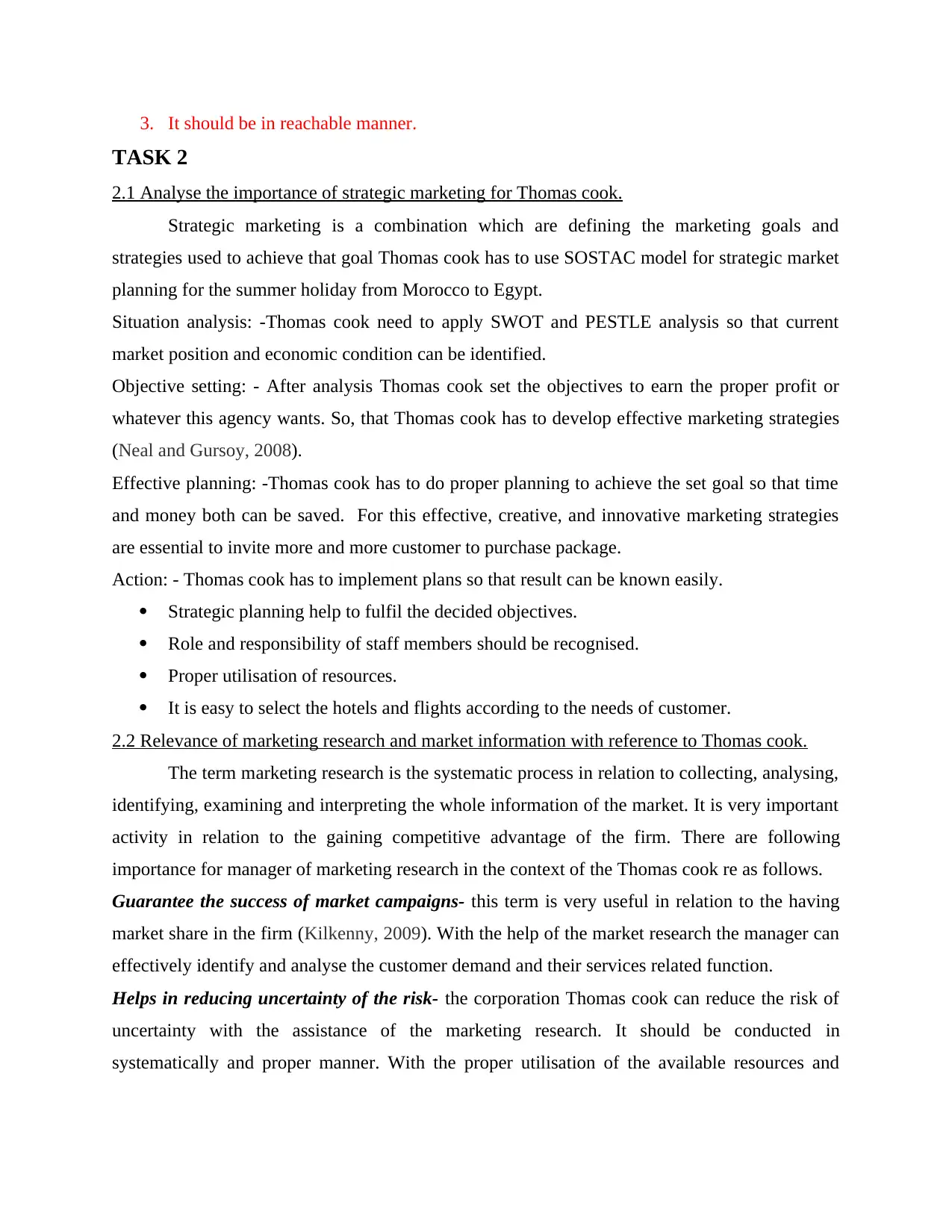
3. It should be in reachable manner.
TASK 2
2.1 Analyse the importance of strategic marketing for Thomas cook.
Strategic marketing is a combination which are defining the marketing goals and
strategies used to achieve that goal Thomas cook has to use SOSTAC model for strategic market
planning for the summer holiday from Morocco to Egypt.
Situation analysis: -Thomas cook need to apply SWOT and PESTLE analysis so that current
market position and economic condition can be identified.
Objective setting: - After analysis Thomas cook set the objectives to earn the proper profit or
whatever this agency wants. So, that Thomas cook has to develop effective marketing strategies
(Neal and Gursoy, 2008).
Effective planning: -Thomas cook has to do proper planning to achieve the set goal so that time
and money both can be saved. For this effective, creative, and innovative marketing strategies
are essential to invite more and more customer to purchase package.
Action: - Thomas cook has to implement plans so that result can be known easily.
Strategic planning help to fulfil the decided objectives.
Role and responsibility of staff members should be recognised.
Proper utilisation of resources.
It is easy to select the hotels and flights according to the needs of customer.
2.2 Relevance of marketing research and market information with reference to Thomas cook.
The term marketing research is the systematic process in relation to collecting, analysing,
identifying, examining and interpreting the whole information of the market. It is very important
activity in relation to the gaining competitive advantage of the firm. There are following
importance for manager of marketing research in the context of the Thomas cook re as follows.
Guarantee the success of market campaigns- this term is very useful in relation to the having
market share in the firm (Kilkenny, 2009). With the help of the market research the manager can
effectively identify and analyse the customer demand and their services related function.
Helps in reducing uncertainty of the risk- the corporation Thomas cook can reduce the risk of
uncertainty with the assistance of the marketing research. It should be conducted in
systematically and proper manner. With the proper utilisation of the available resources and
TASK 2
2.1 Analyse the importance of strategic marketing for Thomas cook.
Strategic marketing is a combination which are defining the marketing goals and
strategies used to achieve that goal Thomas cook has to use SOSTAC model for strategic market
planning for the summer holiday from Morocco to Egypt.
Situation analysis: -Thomas cook need to apply SWOT and PESTLE analysis so that current
market position and economic condition can be identified.
Objective setting: - After analysis Thomas cook set the objectives to earn the proper profit or
whatever this agency wants. So, that Thomas cook has to develop effective marketing strategies
(Neal and Gursoy, 2008).
Effective planning: -Thomas cook has to do proper planning to achieve the set goal so that time
and money both can be saved. For this effective, creative, and innovative marketing strategies
are essential to invite more and more customer to purchase package.
Action: - Thomas cook has to implement plans so that result can be known easily.
Strategic planning help to fulfil the decided objectives.
Role and responsibility of staff members should be recognised.
Proper utilisation of resources.
It is easy to select the hotels and flights according to the needs of customer.
2.2 Relevance of marketing research and market information with reference to Thomas cook.
The term marketing research is the systematic process in relation to collecting, analysing,
identifying, examining and interpreting the whole information of the market. It is very important
activity in relation to the gaining competitive advantage of the firm. There are following
importance for manager of marketing research in the context of the Thomas cook re as follows.
Guarantee the success of market campaigns- this term is very useful in relation to the having
market share in the firm (Kilkenny, 2009). With the help of the market research the manager can
effectively identify and analyse the customer demand and their services related function.
Helps in reducing uncertainty of the risk- the corporation Thomas cook can reduce the risk of
uncertainty with the assistance of the marketing research. It should be conducted in
systematically and proper manner. With the proper utilisation of the available resources and
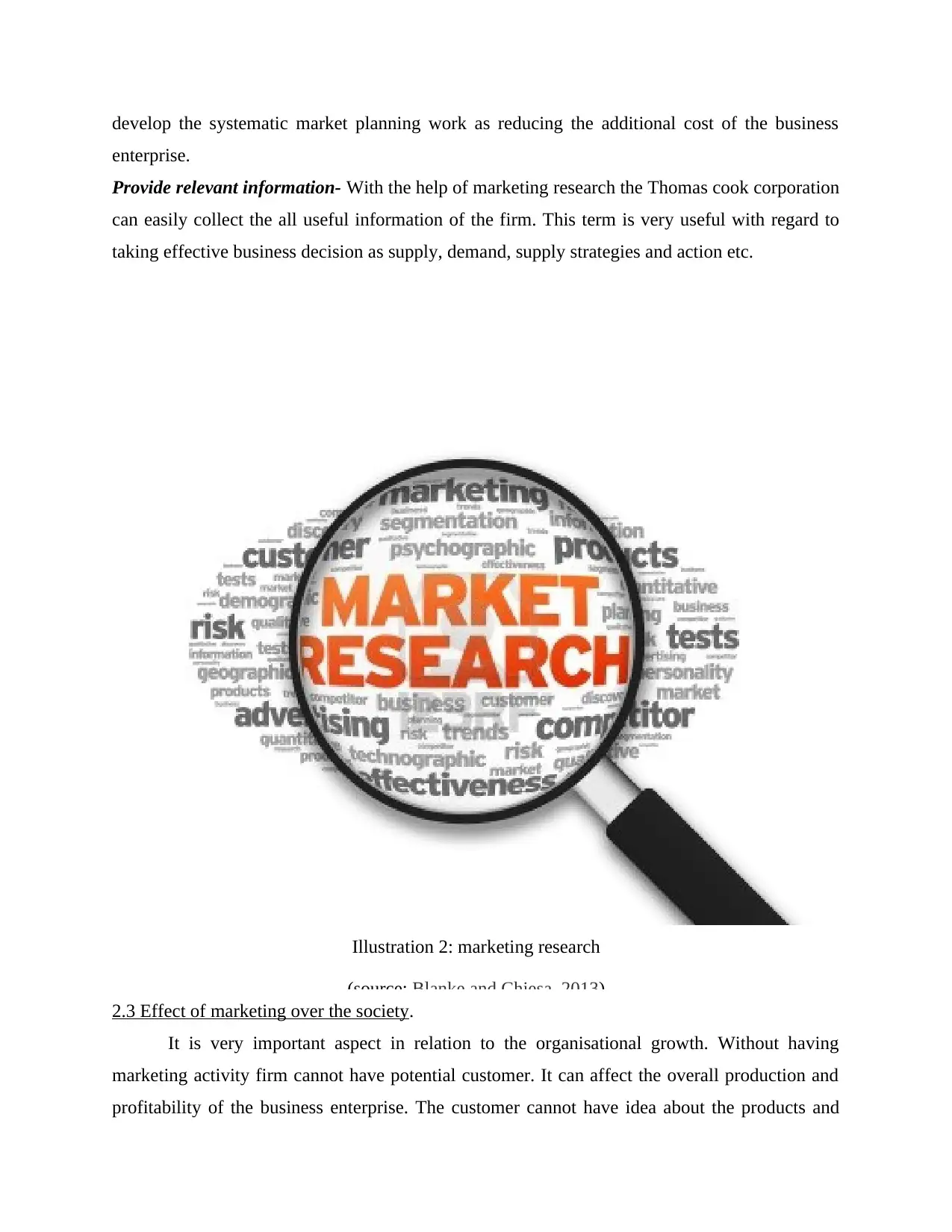
develop the systematic market planning work as reducing the additional cost of the business
enterprise.
Provide relevant information- With the help of marketing research the Thomas cook corporation
can easily collect the all useful information of the firm. This term is very useful with regard to
taking effective business decision as supply, demand, supply strategies and action etc.
2.3 Effect of marketing over the society.
It is very important aspect in relation to the organisational growth. Without having
marketing activity firm cannot have potential customer. It can affect the overall production and
profitability of the business enterprise. The customer cannot have idea about the products and
Illustration 2: marketing research
(source: Blanke and Chiesa, 2013)
enterprise.
Provide relevant information- With the help of marketing research the Thomas cook corporation
can easily collect the all useful information of the firm. This term is very useful with regard to
taking effective business decision as supply, demand, supply strategies and action etc.
2.3 Effect of marketing over the society.
It is very important aspect in relation to the organisational growth. Without having
marketing activity firm cannot have potential customer. It can affect the overall production and
profitability of the business enterprise. The customer cannot have idea about the products and
Illustration 2: marketing research
(source: Blanke and Chiesa, 2013)
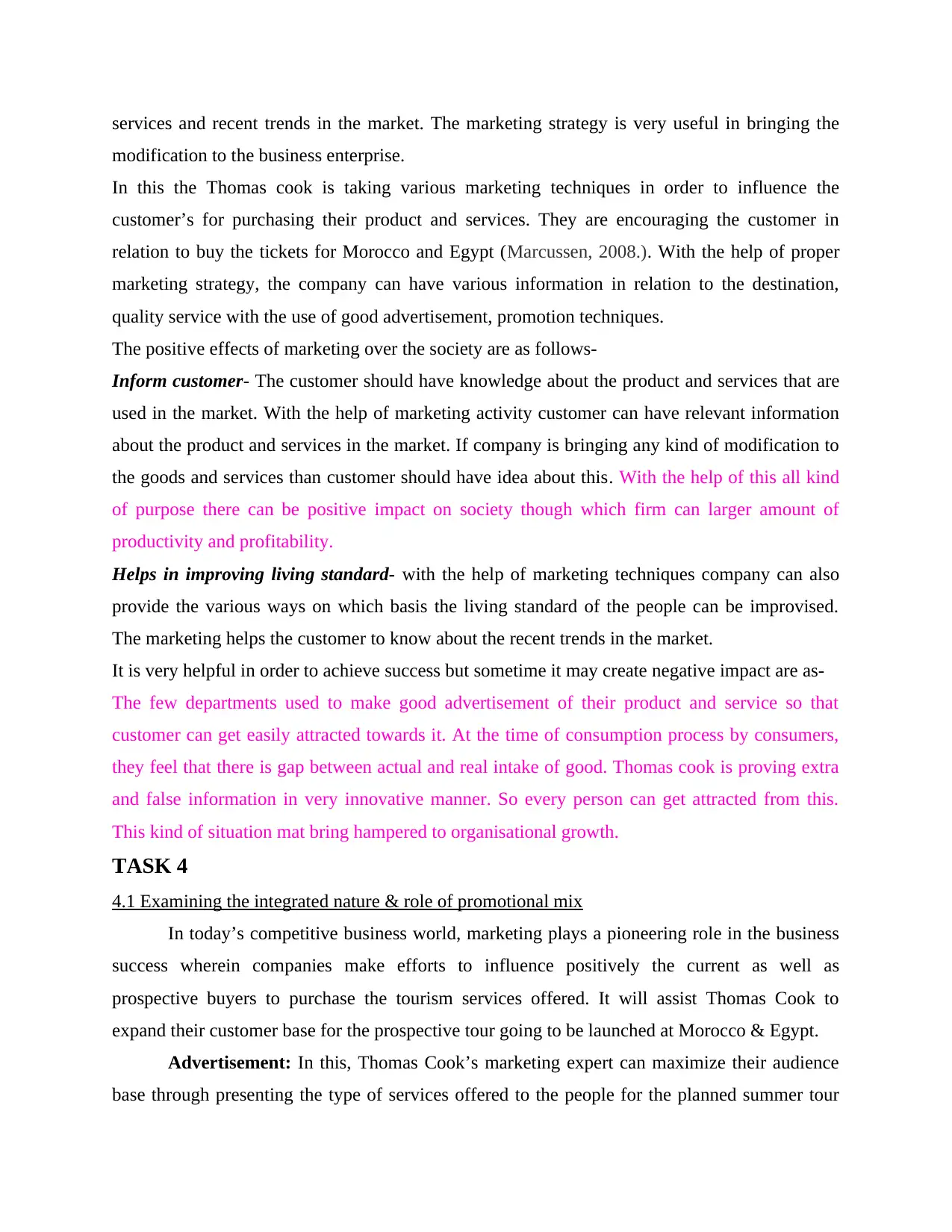
services and recent trends in the market. The marketing strategy is very useful in bringing the
modification to the business enterprise.
In this the Thomas cook is taking various marketing techniques in order to influence the
customer’s for purchasing their product and services. They are encouraging the customer in
relation to buy the tickets for Morocco and Egypt (Marcussen, 2008.). With the help of proper
marketing strategy, the company can have various information in relation to the destination,
quality service with the use of good advertisement, promotion techniques.
The positive effects of marketing over the society are as follows-
Inform customer- The customer should have knowledge about the product and services that are
used in the market. With the help of marketing activity customer can have relevant information
about the product and services in the market. If company is bringing any kind of modification to
the goods and services than customer should have idea about this. With the help of this all kind
of purpose there can be positive impact on society though which firm can larger amount of
productivity and profitability.
Helps in improving living standard- with the help of marketing techniques company can also
provide the various ways on which basis the living standard of the people can be improvised.
The marketing helps the customer to know about the recent trends in the market.
It is very helpful in order to achieve success but sometime it may create negative impact are as-
The few departments used to make good advertisement of their product and service so that
customer can get easily attracted towards it. At the time of consumption process by consumers,
they feel that there is gap between actual and real intake of good. Thomas cook is proving extra
and false information in very innovative manner. So every person can get attracted from this.
This kind of situation mat bring hampered to organisational growth.
TASK 4
4.1 Examining the integrated nature & role of promotional mix
In today’s competitive business world, marketing plays a pioneering role in the business
success wherein companies make efforts to influence positively the current as well as
prospective buyers to purchase the tourism services offered. It will assist Thomas Cook to
expand their customer base for the prospective tour going to be launched at Morocco & Egypt.
Advertisement: In this, Thomas Cook’s marketing expert can maximize their audience
base through presenting the type of services offered to the people for the planned summer tour
modification to the business enterprise.
In this the Thomas cook is taking various marketing techniques in order to influence the
customer’s for purchasing their product and services. They are encouraging the customer in
relation to buy the tickets for Morocco and Egypt (Marcussen, 2008.). With the help of proper
marketing strategy, the company can have various information in relation to the destination,
quality service with the use of good advertisement, promotion techniques.
The positive effects of marketing over the society are as follows-
Inform customer- The customer should have knowledge about the product and services that are
used in the market. With the help of marketing activity customer can have relevant information
about the product and services in the market. If company is bringing any kind of modification to
the goods and services than customer should have idea about this. With the help of this all kind
of purpose there can be positive impact on society though which firm can larger amount of
productivity and profitability.
Helps in improving living standard- with the help of marketing techniques company can also
provide the various ways on which basis the living standard of the people can be improvised.
The marketing helps the customer to know about the recent trends in the market.
It is very helpful in order to achieve success but sometime it may create negative impact are as-
The few departments used to make good advertisement of their product and service so that
customer can get easily attracted towards it. At the time of consumption process by consumers,
they feel that there is gap between actual and real intake of good. Thomas cook is proving extra
and false information in very innovative manner. So every person can get attracted from this.
This kind of situation mat bring hampered to organisational growth.
TASK 4
4.1 Examining the integrated nature & role of promotional mix
In today’s competitive business world, marketing plays a pioneering role in the business
success wherein companies make efforts to influence positively the current as well as
prospective buyers to purchase the tourism services offered. It will assist Thomas Cook to
expand their customer base for the prospective tour going to be launched at Morocco & Egypt.
Advertisement: In this, Thomas Cook’s marketing expert can maximize their audience
base through presenting the type of services offered to the people for the planned summer tour
Secure Best Marks with AI Grader
Need help grading? Try our AI Grader for instant feedback on your assignments.
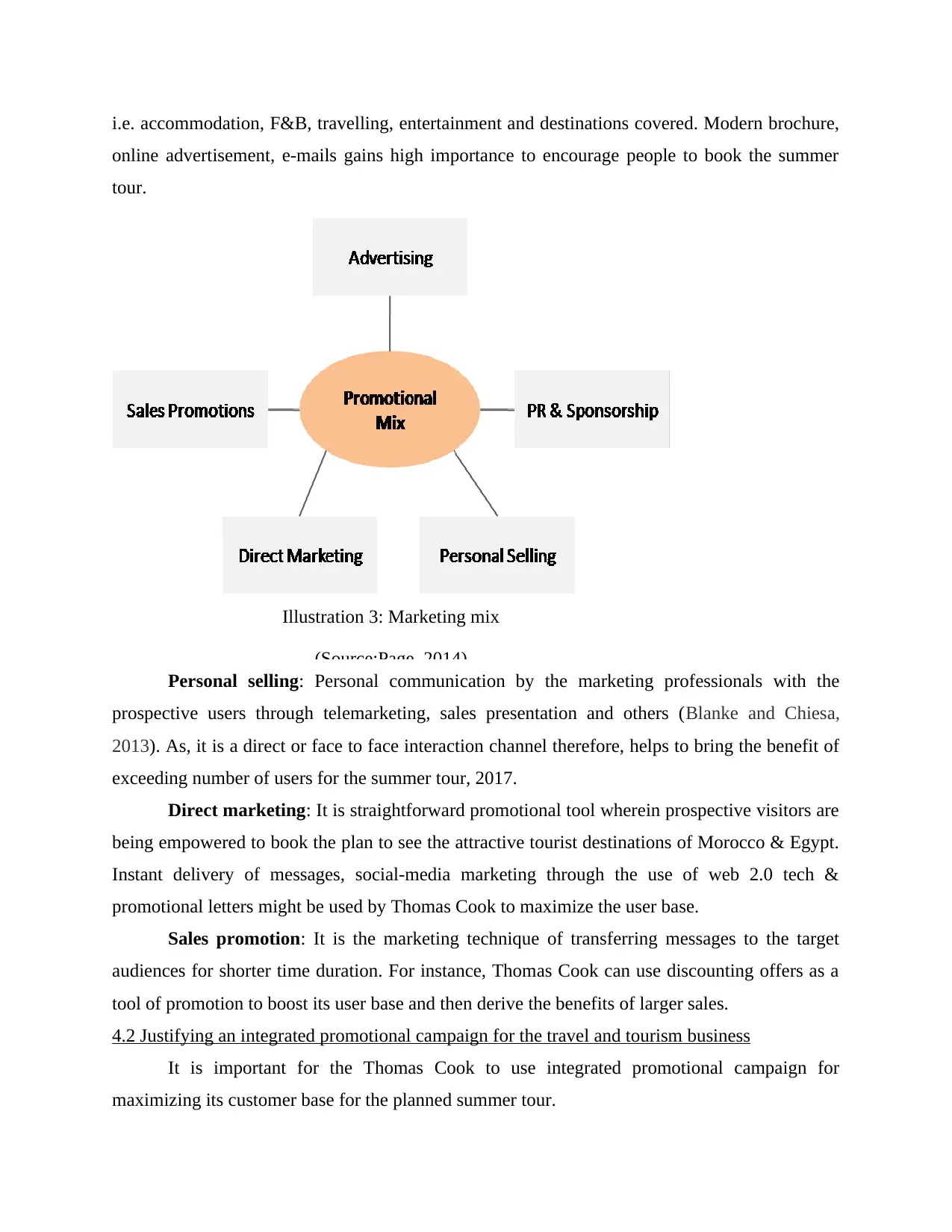
i.e. accommodation, F&B, travelling, entertainment and destinations covered. Modern brochure,
online advertisement, e-mails gains high importance to encourage people to book the summer
tour.
Illustration 3: Marketing mix
(Source:Page, 2014)
Personal selling: Personal communication by the marketing professionals with the
prospective users through telemarketing, sales presentation and others (Blanke and Chiesa,
2013). As, it is a direct or face to face interaction channel therefore, helps to bring the benefit of
exceeding number of users for the summer tour, 2017.
Direct marketing: It is straightforward promotional tool wherein prospective visitors are
being empowered to book the plan to see the attractive tourist destinations of Morocco & Egypt.
Instant delivery of messages, social-media marketing through the use of web 2.0 tech &
promotional letters might be used by Thomas Cook to maximize the user base.
Sales promotion: It is the marketing technique of transferring messages to the target
audiences for shorter time duration. For instance, Thomas Cook can use discounting offers as a
tool of promotion to boost its user base and then derive the benefits of larger sales.
4.2 Justifying an integrated promotional campaign for the travel and tourism business
It is important for the Thomas Cook to use integrated promotional campaign for
maximizing its customer base for the planned summer tour.
online advertisement, e-mails gains high importance to encourage people to book the summer
tour.
Illustration 3: Marketing mix
(Source:Page, 2014)
Personal selling: Personal communication by the marketing professionals with the
prospective users through telemarketing, sales presentation and others (Blanke and Chiesa,
2013). As, it is a direct or face to face interaction channel therefore, helps to bring the benefit of
exceeding number of users for the summer tour, 2017.
Direct marketing: It is straightforward promotional tool wherein prospective visitors are
being empowered to book the plan to see the attractive tourist destinations of Morocco & Egypt.
Instant delivery of messages, social-media marketing through the use of web 2.0 tech &
promotional letters might be used by Thomas Cook to maximize the user base.
Sales promotion: It is the marketing technique of transferring messages to the target
audiences for shorter time duration. For instance, Thomas Cook can use discounting offers as a
tool of promotion to boost its user base and then derive the benefits of larger sales.
4.2 Justifying an integrated promotional campaign for the travel and tourism business
It is important for the Thomas Cook to use integrated promotional campaign for
maximizing its customer base for the planned summer tour.
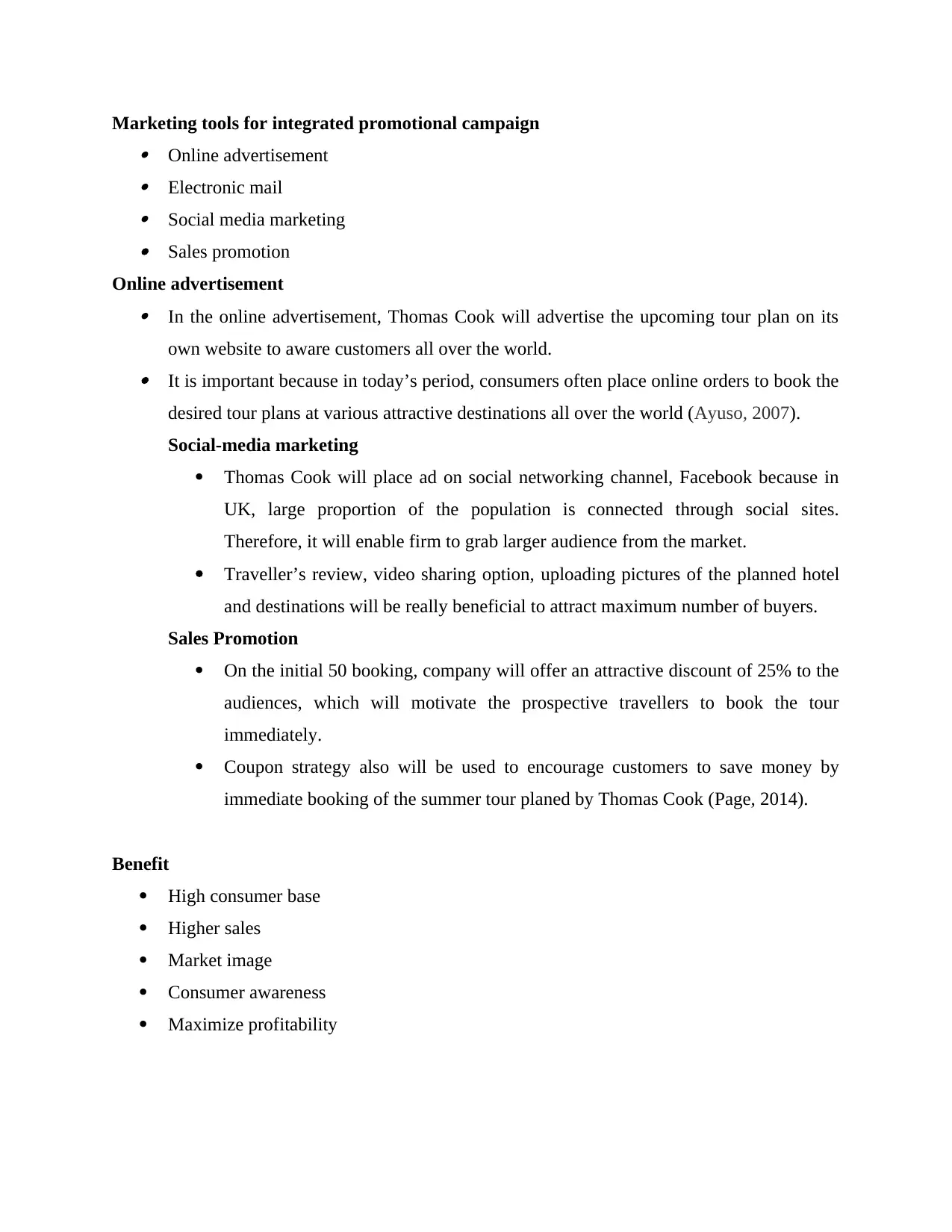
Marketing tools for integrated promotional campaign Online advertisement Electronic mail Social media marketing Sales promotion
Online advertisement In the online advertisement, Thomas Cook will advertise the upcoming tour plan on its
own website to aware customers all over the world. It is important because in today’s period, consumers often place online orders to book the
desired tour plans at various attractive destinations all over the world (Ayuso, 2007).
Social-media marketing
Thomas Cook will place ad on social networking channel, Facebook because in
UK, large proportion of the population is connected through social sites.
Therefore, it will enable firm to grab larger audience from the market.
Traveller’s review, video sharing option, uploading pictures of the planned hotel
and destinations will be really beneficial to attract maximum number of buyers.
Sales Promotion
On the initial 50 booking, company will offer an attractive discount of 25% to the
audiences, which will motivate the prospective travellers to book the tour
immediately.
Coupon strategy also will be used to encourage customers to save money by
immediate booking of the summer tour planed by Thomas Cook (Page, 2014).
Benefit
High consumer base
Higher sales
Market image
Consumer awareness
Maximize profitability
Online advertisement In the online advertisement, Thomas Cook will advertise the upcoming tour plan on its
own website to aware customers all over the world. It is important because in today’s period, consumers often place online orders to book the
desired tour plans at various attractive destinations all over the world (Ayuso, 2007).
Social-media marketing
Thomas Cook will place ad on social networking channel, Facebook because in
UK, large proportion of the population is connected through social sites.
Therefore, it will enable firm to grab larger audience from the market.
Traveller’s review, video sharing option, uploading pictures of the planned hotel
and destinations will be really beneficial to attract maximum number of buyers.
Sales Promotion
On the initial 50 booking, company will offer an attractive discount of 25% to the
audiences, which will motivate the prospective travellers to book the tour
immediately.
Coupon strategy also will be used to encourage customers to save money by
immediate booking of the summer tour planed by Thomas Cook (Page, 2014).
Benefit
High consumer base
Higher sales
Market image
Consumer awareness
Maximize profitability
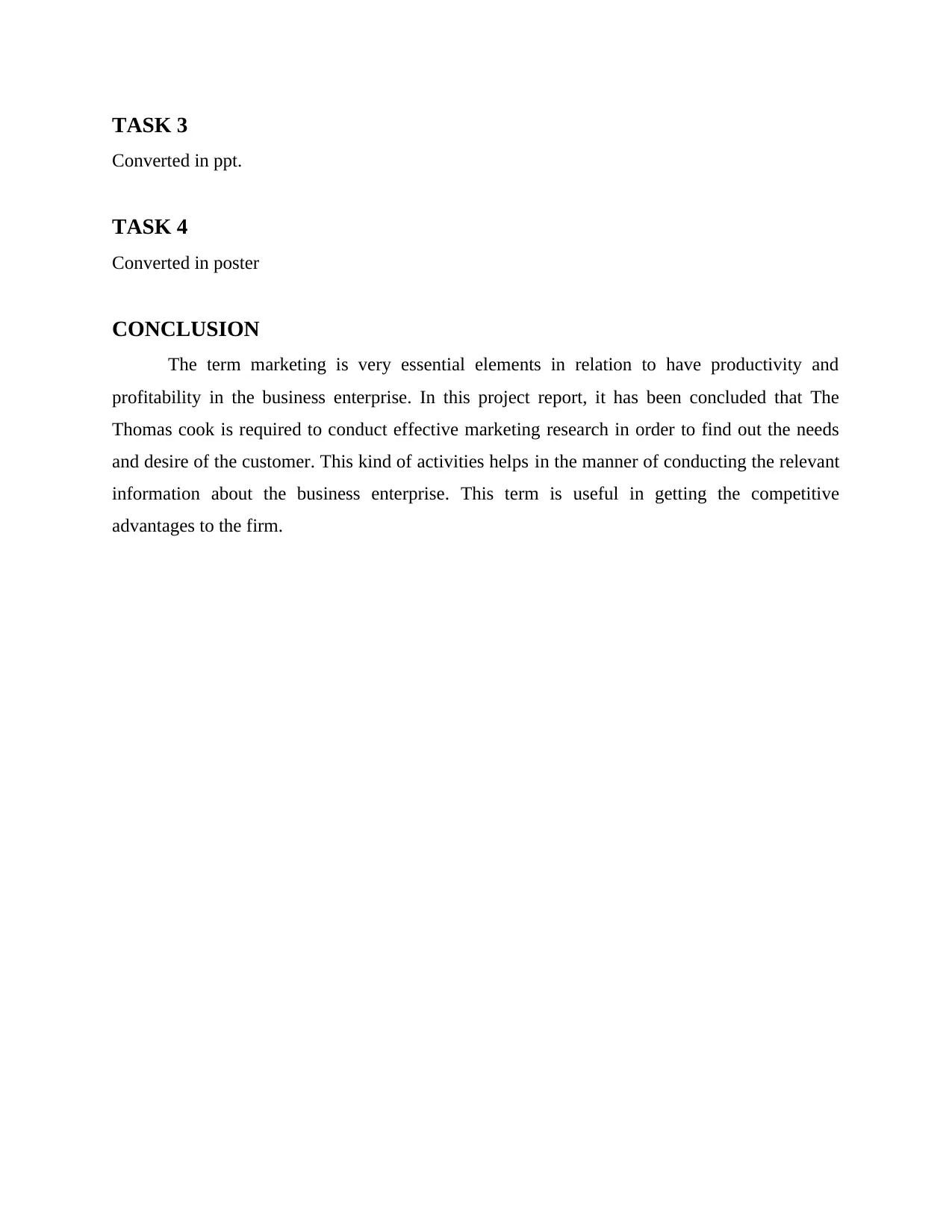
TASK 3
Converted in ppt.
TASK 4
Converted in poster
CONCLUSION
The term marketing is very essential elements in relation to have productivity and
profitability in the business enterprise. In this project report, it has been concluded that The
Thomas cook is required to conduct effective marketing research in order to find out the needs
and desire of the customer. This kind of activities helps in the manner of conducting the relevant
information about the business enterprise. This term is useful in getting the competitive
advantages to the firm.
Converted in ppt.
TASK 4
Converted in poster
CONCLUSION
The term marketing is very essential elements in relation to have productivity and
profitability in the business enterprise. In this project report, it has been concluded that The
Thomas cook is required to conduct effective marketing research in order to find out the needs
and desire of the customer. This kind of activities helps in the manner of conducting the relevant
information about the business enterprise. This term is useful in getting the competitive
advantages to the firm.
Paraphrase This Document
Need a fresh take? Get an instant paraphrase of this document with our AI Paraphraser
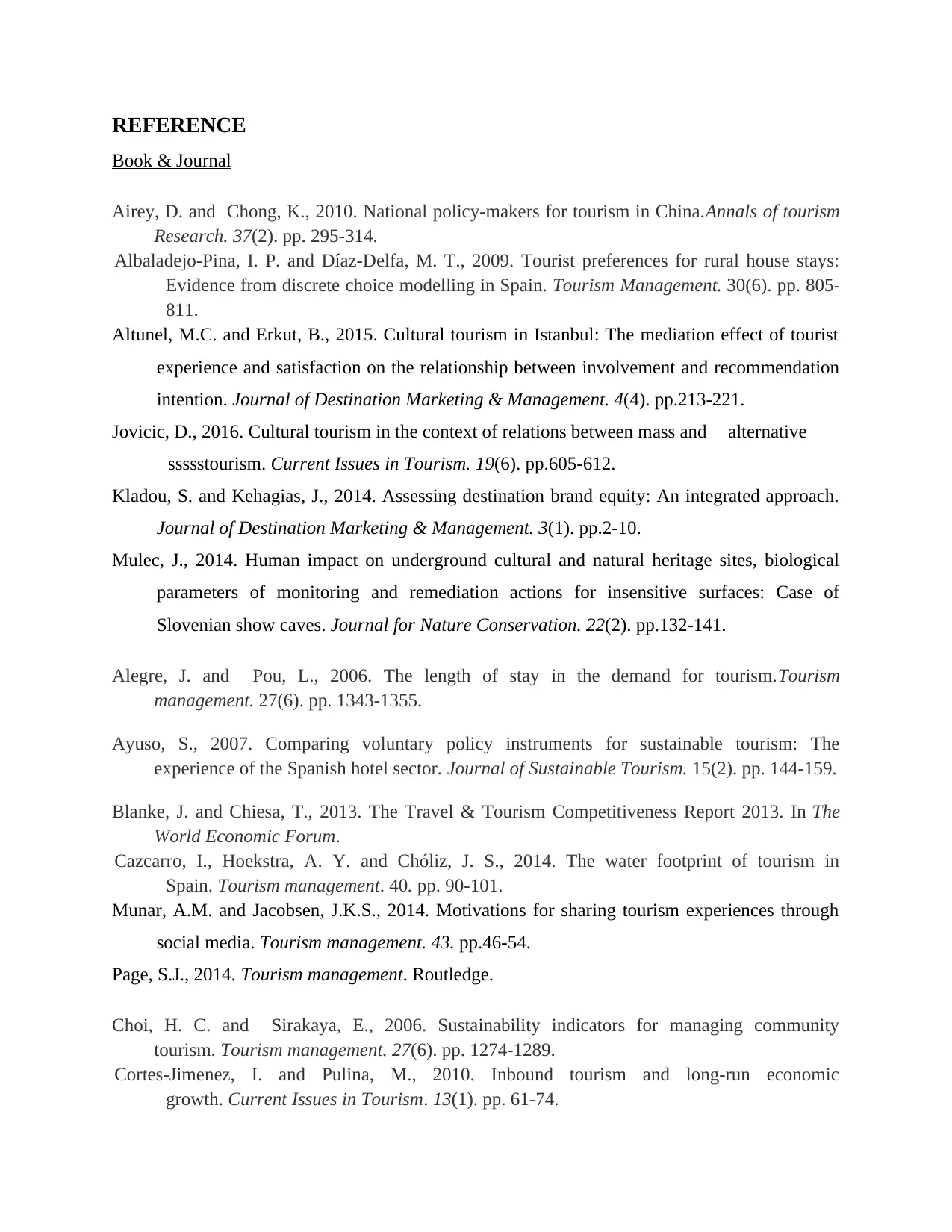
REFERENCE
Book & Journal
Airey, D. and Chong, K., 2010. National policy-makers for tourism in China.Annals of tourism
Research. 37(2). pp. 295-314.
Albaladejo-Pina, I. P. and Díaz-Delfa, M. T., 2009. Tourist preferences for rural house stays:
Evidence from discrete choice modelling in Spain. Tourism Management. 30(6). pp. 805-
811.
Altunel, M.C. and Erkut, B., 2015. Cultural tourism in Istanbul: The mediation effect of tourist
experience and satisfaction on the relationship between involvement and recommendation
intention. Journal of Destination Marketing & Management. 4(4). pp.213-221.
Jovicic, D., 2016. Cultural tourism in the context of relations between mass and alternative
ssssstourism. Current Issues in Tourism. 19(6). pp.605-612.
Kladou, S. and Kehagias, J., 2014. Assessing destination brand equity: An integrated approach.
Journal of Destination Marketing & Management. 3(1). pp.2-10.
Mulec, J., 2014. Human impact on underground cultural and natural heritage sites, biological
parameters of monitoring and remediation actions for insensitive surfaces: Case of
Slovenian show caves. Journal for Nature Conservation. 22(2). pp.132-141.
Alegre, J. and Pou, L., 2006. The length of stay in the demand for tourism.Tourism
management. 27(6). pp. 1343-1355.
Ayuso, S., 2007. Comparing voluntary policy instruments for sustainable tourism: The
experience of the Spanish hotel sector. Journal of Sustainable Tourism. 15(2). pp. 144-159.
Blanke, J. and Chiesa, T., 2013. The Travel & Tourism Competitiveness Report 2013. In The
World Economic Forum.
Cazcarro, I., Hoekstra, A. Y. and Chóliz, J. S., 2014. The water footprint of tourism in
Spain. Tourism management. 40. pp. 90-101.
Munar, A.M. and Jacobsen, J.K.S., 2014. Motivations for sharing tourism experiences through
social media. Tourism management. 43. pp.46-54.
Page, S.J., 2014. Tourism management. Routledge.
Choi, H. C. and Sirakaya, E., 2006. Sustainability indicators for managing community
tourism. Tourism management. 27(6). pp. 1274-1289.
Cortes-Jimenez, I. and Pulina, M., 2010. Inbound tourism and long-run economic
growth. Current Issues in Tourism. 13(1). pp. 61-74.
Book & Journal
Airey, D. and Chong, K., 2010. National policy-makers for tourism in China.Annals of tourism
Research. 37(2). pp. 295-314.
Albaladejo-Pina, I. P. and Díaz-Delfa, M. T., 2009. Tourist preferences for rural house stays:
Evidence from discrete choice modelling in Spain. Tourism Management. 30(6). pp. 805-
811.
Altunel, M.C. and Erkut, B., 2015. Cultural tourism in Istanbul: The mediation effect of tourist
experience and satisfaction on the relationship between involvement and recommendation
intention. Journal of Destination Marketing & Management. 4(4). pp.213-221.
Jovicic, D., 2016. Cultural tourism in the context of relations between mass and alternative
ssssstourism. Current Issues in Tourism. 19(6). pp.605-612.
Kladou, S. and Kehagias, J., 2014. Assessing destination brand equity: An integrated approach.
Journal of Destination Marketing & Management. 3(1). pp.2-10.
Mulec, J., 2014. Human impact on underground cultural and natural heritage sites, biological
parameters of monitoring and remediation actions for insensitive surfaces: Case of
Slovenian show caves. Journal for Nature Conservation. 22(2). pp.132-141.
Alegre, J. and Pou, L., 2006. The length of stay in the demand for tourism.Tourism
management. 27(6). pp. 1343-1355.
Ayuso, S., 2007. Comparing voluntary policy instruments for sustainable tourism: The
experience of the Spanish hotel sector. Journal of Sustainable Tourism. 15(2). pp. 144-159.
Blanke, J. and Chiesa, T., 2013. The Travel & Tourism Competitiveness Report 2013. In The
World Economic Forum.
Cazcarro, I., Hoekstra, A. Y. and Chóliz, J. S., 2014. The water footprint of tourism in
Spain. Tourism management. 40. pp. 90-101.
Munar, A.M. and Jacobsen, J.K.S., 2014. Motivations for sharing tourism experiences through
social media. Tourism management. 43. pp.46-54.
Page, S.J., 2014. Tourism management. Routledge.
Choi, H. C. and Sirakaya, E., 2006. Sustainability indicators for managing community
tourism. Tourism management. 27(6). pp. 1274-1289.
Cortes-Jimenez, I. and Pulina, M., 2010. Inbound tourism and long-run economic
growth. Current Issues in Tourism. 13(1). pp. 61-74.
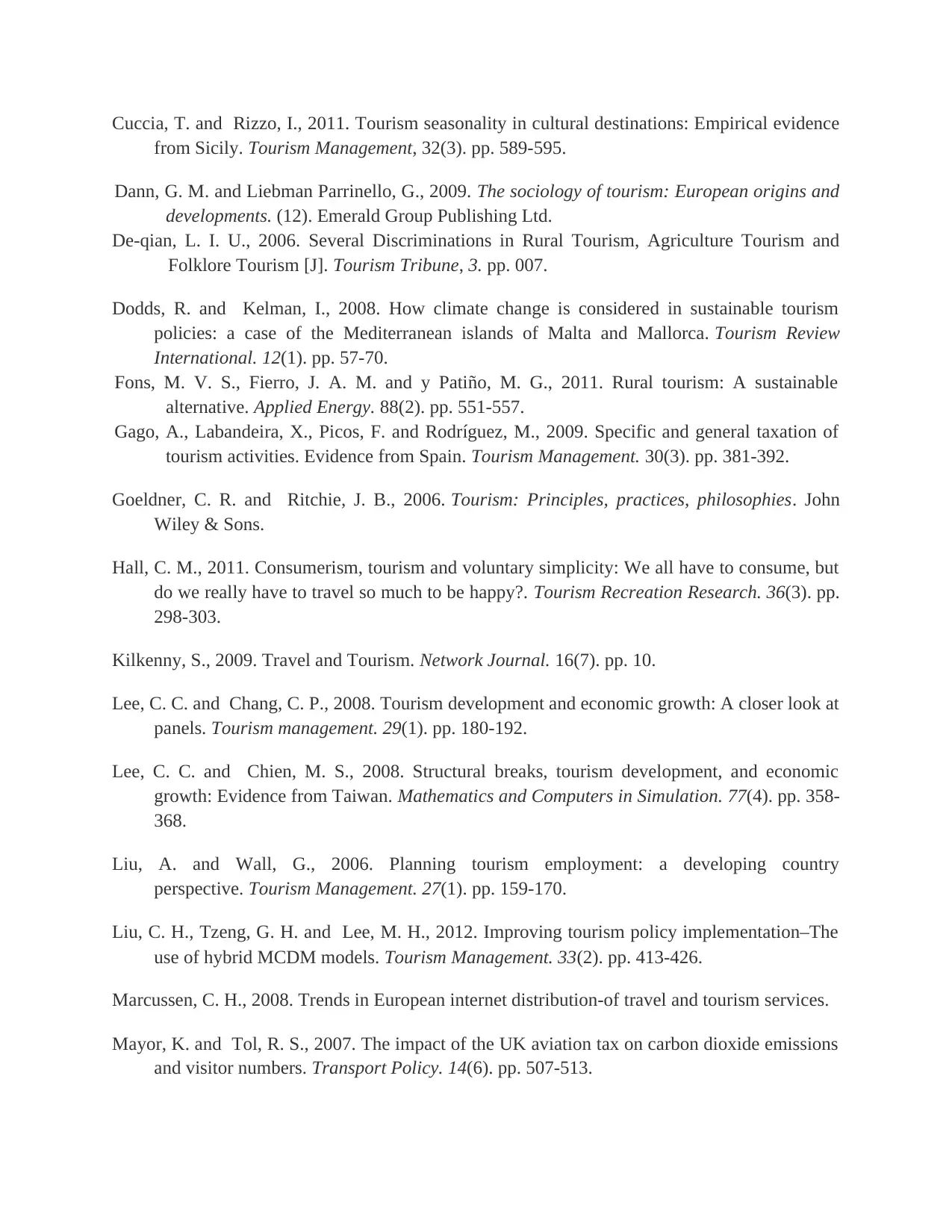
Cuccia, T. and Rizzo, I., 2011. Tourism seasonality in cultural destinations: Empirical evidence
from Sicily. Tourism Management, 32(3). pp. 589-595.
Dann, G. M. and Liebman Parrinello, G., 2009. The sociology of tourism: European origins and
developments. (12). Emerald Group Publishing Ltd.
De-qian, L. I. U., 2006. Several Discriminations in Rural Tourism, Agriculture Tourism and
Folklore Tourism [J]. Tourism Tribune, 3. pp. 007.
Dodds, R. and Kelman, I., 2008. How climate change is considered in sustainable tourism
policies: a case of the Mediterranean islands of Malta and Mallorca. Tourism Review
International. 12(1). pp. 57-70.
Fons, M. V. S., Fierro, J. A. M. and y Patiño, M. G., 2011. Rural tourism: A sustainable
alternative. Applied Energy. 88(2). pp. 551-557.
Gago, A., Labandeira, X., Picos, F. and Rodríguez, M., 2009. Specific and general taxation of
tourism activities. Evidence from Spain. Tourism Management. 30(3). pp. 381-392.
Goeldner, C. R. and Ritchie, J. B., 2006. Tourism: Principles, practices, philosophies. John
Wiley & Sons.
Hall, C. M., 2011. Consumerism, tourism and voluntary simplicity: We all have to consume, but
do we really have to travel so much to be happy?. Tourism Recreation Research. 36(3). pp.
298-303.
Kilkenny, S., 2009. Travel and Tourism. Network Journal. 16(7). pp. 10.
Lee, C. C. and Chang, C. P., 2008. Tourism development and economic growth: A closer look at
panels. Tourism management. 29(1). pp. 180-192.
Lee, C. C. and Chien, M. S., 2008. Structural breaks, tourism development, and economic
growth: Evidence from Taiwan. Mathematics and Computers in Simulation. 77(4). pp. 358-
368.
Liu, A. and Wall, G., 2006. Planning tourism employment: a developing country
perspective. Tourism Management. 27(1). pp. 159-170.
Liu, C. H., Tzeng, G. H. and Lee, M. H., 2012. Improving tourism policy implementation–The
use of hybrid MCDM models. Tourism Management. 33(2). pp. 413-426.
Marcussen, C. H., 2008. Trends in European internet distribution-of travel and tourism services.
Mayor, K. and Tol, R. S., 2007. The impact of the UK aviation tax on carbon dioxide emissions
and visitor numbers. Transport Policy. 14(6). pp. 507-513.
from Sicily. Tourism Management, 32(3). pp. 589-595.
Dann, G. M. and Liebman Parrinello, G., 2009. The sociology of tourism: European origins and
developments. (12). Emerald Group Publishing Ltd.
De-qian, L. I. U., 2006. Several Discriminations in Rural Tourism, Agriculture Tourism and
Folklore Tourism [J]. Tourism Tribune, 3. pp. 007.
Dodds, R. and Kelman, I., 2008. How climate change is considered in sustainable tourism
policies: a case of the Mediterranean islands of Malta and Mallorca. Tourism Review
International. 12(1). pp. 57-70.
Fons, M. V. S., Fierro, J. A. M. and y Patiño, M. G., 2011. Rural tourism: A sustainable
alternative. Applied Energy. 88(2). pp. 551-557.
Gago, A., Labandeira, X., Picos, F. and Rodríguez, M., 2009. Specific and general taxation of
tourism activities. Evidence from Spain. Tourism Management. 30(3). pp. 381-392.
Goeldner, C. R. and Ritchie, J. B., 2006. Tourism: Principles, practices, philosophies. John
Wiley & Sons.
Hall, C. M., 2011. Consumerism, tourism and voluntary simplicity: We all have to consume, but
do we really have to travel so much to be happy?. Tourism Recreation Research. 36(3). pp.
298-303.
Kilkenny, S., 2009. Travel and Tourism. Network Journal. 16(7). pp. 10.
Lee, C. C. and Chang, C. P., 2008. Tourism development and economic growth: A closer look at
panels. Tourism management. 29(1). pp. 180-192.
Lee, C. C. and Chien, M. S., 2008. Structural breaks, tourism development, and economic
growth: Evidence from Taiwan. Mathematics and Computers in Simulation. 77(4). pp. 358-
368.
Liu, A. and Wall, G., 2006. Planning tourism employment: a developing country
perspective. Tourism Management. 27(1). pp. 159-170.
Liu, C. H., Tzeng, G. H. and Lee, M. H., 2012. Improving tourism policy implementation–The
use of hybrid MCDM models. Tourism Management. 33(2). pp. 413-426.
Marcussen, C. H., 2008. Trends in European internet distribution-of travel and tourism services.
Mayor, K. and Tol, R. S., 2007. The impact of the UK aviation tax on carbon dioxide emissions
and visitor numbers. Transport Policy. 14(6). pp. 507-513.
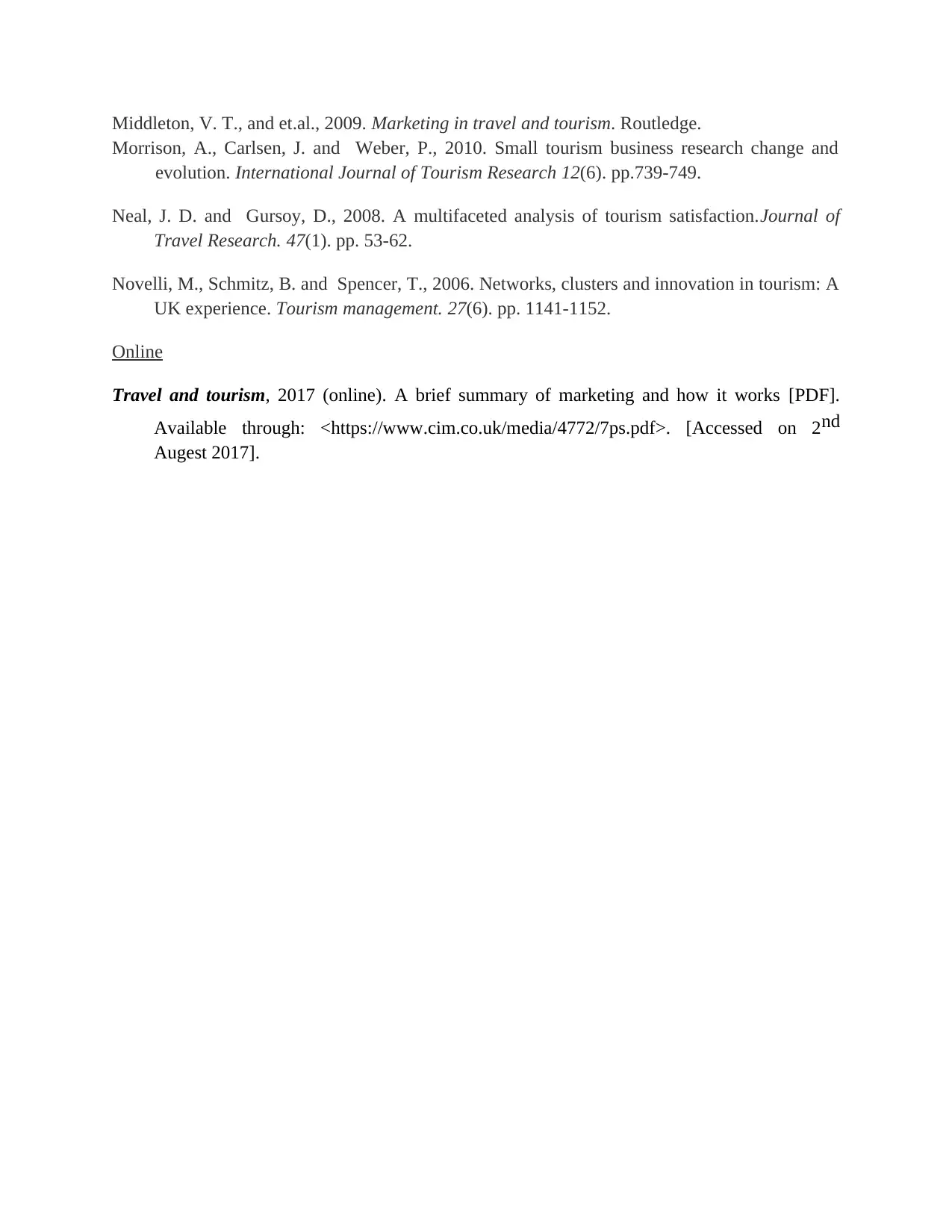
Middleton, V. T., and et.al., 2009. Marketing in travel and tourism. Routledge.
Morrison, A., Carlsen, J. and Weber, P., 2010. Small tourism business research change and
evolution. International Journal of Tourism Research 12(6). pp.739-749.
Neal, J. D. and Gursoy, D., 2008. A multifaceted analysis of tourism satisfaction.Journal of
Travel Research. 47(1). pp. 53-62.
Novelli, M., Schmitz, B. and Spencer, T., 2006. Networks, clusters and innovation in tourism: A
UK experience. Tourism management. 27(6). pp. 1141-1152.
Online
Travel and tourism, 2017 (online). A brief summary of marketing and how it works [PDF].
Available through: <https://www.cim.co.uk/media/4772/7ps.pdf>. [Accessed on 2nd
Augest 2017].
Morrison, A., Carlsen, J. and Weber, P., 2010. Small tourism business research change and
evolution. International Journal of Tourism Research 12(6). pp.739-749.
Neal, J. D. and Gursoy, D., 2008. A multifaceted analysis of tourism satisfaction.Journal of
Travel Research. 47(1). pp. 53-62.
Novelli, M., Schmitz, B. and Spencer, T., 2006. Networks, clusters and innovation in tourism: A
UK experience. Tourism management. 27(6). pp. 1141-1152.
Online
Travel and tourism, 2017 (online). A brief summary of marketing and how it works [PDF].
Available through: <https://www.cim.co.uk/media/4772/7ps.pdf>. [Accessed on 2nd
Augest 2017].
1 out of 16
Related Documents
Your All-in-One AI-Powered Toolkit for Academic Success.
+13062052269
info@desklib.com
Available 24*7 on WhatsApp / Email
![[object Object]](/_next/static/media/star-bottom.7253800d.svg)
Unlock your academic potential
© 2024 | Zucol Services PVT LTD | All rights reserved.





